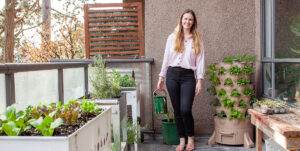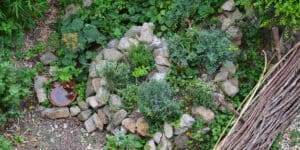Understanding the importance of the sun and its movements is key in permaculture landscape design. Finding the sun’s path over your house is one of the first things you should do to understand the land you live on.
The Importance of Sunlight in Permaculture Design
Understanding the importance of our sun and the energy it provides is crucial in permaculture design.
Before you set out to determine the sun’s path over your property and what it means to you, it is a good idea to spend a little time thinking about how, through your design, you can harness the energy of the sun to the fullest – making the most of all the light and heat it provides.
In permaculture, we use and value renewable resources and sunlight falling on our properties is one of the key natural resources at our disposal. The Sun is the solar pinnacle of our world, around which everything revolves and through which so much can grow and thrive.
When we have a clear picture of how we can harness the power of the sun, in different ways, we can begin to see the bigger picture and can clearly see why knowing where the sun travels across our skies is so important.
Using Renewable Solar Energy
When we talk about using renewable solar energy, most people’s minds will likely leap immediately to some sort of photo-voltaic panel used to generate electricity. PV panels and solar-hot water heating are active solar strategies that can indeed find a place in many permaculture designs.
However, it is also important to consider passive solar – how we can take advantage of and use the energy of the sun, catch and store that energy without any intermediary stage.
Passive solar design involves looking at design and materials use to make sure that we can harness the power of the sun, making the most of the heat and light it provides when these are required, and excluding heat when it is not desirable.
This might include, for example, large eaves on a roofline that exclude sunlight from an internal space when it is warmest in summer, but allow it to enter inside when it is lower in the sky during the winter months.
It might include planting deciduous trees in specific locations to keep a room inside a home cooler during hottest times but allowing light into the space when it is colder.
Passive solar design also involves using thermally massive materials like stone, soil or water, for example, brick or ceramics, to catch and store heat energy from the sun during the day, then release that heat slowly when temperatures fall.
Materials with high thermal mass are good at absorbing thermal energy. They help to regulate temperatures, keeping things cooler in summer and warmer in winter and reducing extreme temperature fluctuations.
You may have noticed, for example, a south-facing stone wall becoming warm when the sun shines on it. We can take advantage of that property in our homes and in our gardens to reduce heating needs, or keep an area frost-free, for example.
In a built environment, passive solar design means building-in an understanding of the sun and its pathways and properties from the beginning. When we understand where sunlight will penetrate, when, we can take advantage of it far more effectively.
Beyond these sustainable design considerations in architecture and in our gardens, we can also think about other ways that we might use renewable energy from the sun.
For example, we might harness that power for direct solar water heating, for dehydration or curing of the produce we grow, or even for cooking if we create or purchase a solar oven or solar cooker.
Maximizing Photosynthesis
One other crucial way that we make use of the energy that the sun provides is by gardening. Growing plants in our outdoor spaces is another way to make the most of solar power.
Plants take sunlight and , through the process of photosynthesis, convert solar light energy into chemical energy – taking in water and carbon dioxide to create oxygen, and food for themselves, and ultimately, also for us and other animals.
In permaculture design, we seek to work with nature, harnessing its power for the good of people and planet. We must remember that photosynthesis supplies most of the energy required for life on Earth.
Maximising photosynthesis, therefore, is a key goal in permaculture design and planting. We can do this, for example, by ensuring that we:
- Choose the right plants for where we live, and keeping them in optimal health with consideration of water, soil health etc…
- Ensure that plants get the sunlight they require (positioning them optimally).
- Make the most of space in all the growing areas available to us. (Using strategies like vertical gardening, for example, to make the most of all vertical as well as horizontal space.)
- Create layered planting schemes (like a forest garden).
- Make the most of time as well as space. (Have living plants in place throughout as much of the year as possible…)
Analyzing Sunshine and Shade to Choose the Right Plants for the Right Places
Of course, in order to choose the right plants for the right places, the path of the sun through each day and throughout the year is a very important aspect to consider.
Finding the sun’s path over your house and garden, and mapping sunlight and shade, are essential in creating functioning growing spaces that can stand the test of time and be as productive as you require and desire them to be.
Different plants naturally have different sunlight requirements. We will often talk about plants that require full sun, those that require partial, light or dappled shade, and those that enjoy or can tolerate a position in deep shade.
When we are talking about food producing plants, we can find examples in each of these categories. But of course, many of our most common edible plants and crops require as much sunlight as possible. The availability of sunlight in a particular site is one of the key environmental factors that will determine the yield possible in a given situation.
However, the converse can also be true. Sometimes, restricting sunlight through creating or making use of shade can allow you to obtain a higher yield from a garden.
This is why it can be so important to chart the sun’s path and map sunlight and shade before we decide to place different growing areas and determine a layout for our gardens.
Considering How Sunlight Affects Human Use of a Space
As well as looking at broader issues of energy use and plant productivity, analysing sunlight also allows us to understand better how we ourselves could and should make use of a space.
Understanding where the sunlight comes from throughout each day and throughout the year can help us plan and orient key features within a design – and lay out our homes and gardens to make our own lives as pleasant, comfortable and appealing as possible.
For example, it can help us see where to position a seating area to use during the morning, in the middle of the day, or as evening approaches. It can help us determine what we need to do if we want to be in the sun, and when and where it would be beneficial to have some shade.
We may crave the light and heat of the sun, or wish to escape its glare, in order to keep our bodies at a comfortable temperature and for visual comfort or appeal.
We also make use of the sun for other things – to dry our clothes and linens, for example, in a natural way. So we can think about where a washing line, as well as seating areas, might best be positioned… to give just one example.
Looking at the Big Picture: Understanding Natural Cycles
Most of us surely know that our Earth revolves in an elliptical orbit around our Sun, making one complete cycle in a sidereal year, which is a little over 365 days.
Most will be at least vaguely aware of the science surrounding our annual calendar, and how our planet’s proximity to and rotation as it spins around the sun, and our location on the planet’s surface dictate the day-length and seasons throughout the year.
Delving a little deeper, we can learn that due to the earth’s axial tilt, the inclination of the sun’s journey across our sky (as viewed from our viewpoint on the surface) varies over the course of the year.
At midsummer, the pole of our hemisphere is closest to the sun, due to this tilt. And at midwinter, the pole of our hemisphere is furthest away. At midsummer, the sun therefore appears to travel higher in the sky, and the day lasts longer. While during the winter, the sun is lower and the days shorter.
When we talk about finding the sun’s path over your house, it is important to remember that it is really we who move relative to the sun, and not the other way round. The sun’s path is something that we view from our own perspective on the planet’s surface, in our particular location. And that this path changes throughout the year.
The Summer and Winter Solstices
The summer solstices are when the pole of the hemisphere you live in is tilted most towards the sun. On this day, the period of daylight is longest and the night is the shortest. The sun takes its highest position in the sky. In the Arctic or Antarctic Circle, there is continuous daylight at this time.
The winter solstices are when the pole of the hemisphere you live in its at its maximum tilt away from the sun. Days are short and nights are longer. The sun is at its lowest maximum elevation in the sky. In the Arctic or Antarctic Circle, there is continuous darkness.
Getting the Basic Information About a Site: Sectors Mapping in Permaculture Design
One of the most important tools to have when it comes to permaculture design are good powers of observation.
Observational skills will help you to look at sectors and flow and develop an overall zoning strategy and plan for your garden. Good observational skills will also be crucial as you hone in on the detail, and as you look at what works and what doesn’t over time.
Just some time spent up front to truly know and understand your property can be the number one thing that prevents problems down the road.
In the early stages of a design, mapping sectors involves looking closely at the movement of the sun, the path it takes across your property, and how and where its light falls.
Things that we can determine for a particular site that are important in sectors mapping and determining the path of the sun are:
- Dawn – the beginning of the time of twilight before sunrise.
- Sunrise – the time at which the sun rises above the horizon.
- Altitude (at a given time) – the angle between the centre of the sun and the horizon.
- Culmination – the time of day at which the run reaches its highest elevation in the sky.
- Sunset – the time at which the highest part of the sun drops below the horizon.
- Dusk – the end of the period of twilight after sunset and the onset of darkness.
It can be a good idea to begin by finding this data for the summer and winter solstices. From those data points, you can begin to build up a picture of the appearance and patterns of apparent movement through each day, and how that changes throughout the year.
Tools for Sectors Information
Fortunately, we do not need to record all of this information for ourselves. Today, we can use online information from sites such as www.suncalc.org to find these pieces of information for where we live and our precise locations, wherever we live around the world.
Mapping the Path of the Sun
By recording the information above for different days throughout the year, especially the solstices of summer and winter, we can chart the parabolic arc that the sun takes across the sky from our perspective.
Some people are surprised by how much this alters throughout the year in their location. We are all used to thinking about the sun rising in the east and setting in the west. It passes across the sky to the south in the northern hemisphere (and to the north in the southern hemisphere).
But actually, where I live, for example, the sun rises approximately in the north-east in midsummer, and the south-east in midwinter and sets in midwinter in the south-west, and in midsummer in the north-west. And the sun is significantly lower in the sky during the winter than it is during the height of summer.
Creating a Sun Map
Once you have determined the sun’s path over your house and garden, the next step is to think about what this information means for the environmental conditions where you live.
Working from the information you have gathered about the path of the sun during the day, and throughout each year, you can begin to work out which areas will be in darkness and light, which in shade and which in full sun.
Remember, as well as the path of the sun, other factors will determine whether certain parts of a space are in sunlight or shade. The passage of the sun across the sky might be obscured by surrounding buildings, fences or walls. As the sun passes behind features of the built environment, areas of shade will be cast.
Of course, trees, shrubs and other vegetation, as well as hills and other topographical features within the surrounding landscape can also influence where and when sunlight falls in your garden.
This is why understanding the path of the sun over your property is just the beginning. Since terrestrial features, both natural and man-made, will have a bearing on how much sunlight your home and garden actually receive, and when.
Observation is key to determining the actual sun conditions where you live during each day and throughout the year. Both inside your home, and in your garden, it can be helpful to chart not only the path of the sun through the sky but also the pattern of sunlight on the ground, and the areas of shade cast at different times.
Once we have this basic environmental information, we can move from the broader picture, from the patterns of the natural world to the specific details of a design. But without this information, we cannot hope to create the optimal design and make the right decisions for ourselves and our site.







